Defeating The Enemy According To Zen Buddhism

Oriental philosophies see the struggle with completely different eyes than Westerners. For many of these Eastern schools, defeating the enemy does not mean overthrowing, destroying, or nullifying them. For these schools, winning means neutralizing someone who wants to hurt us and, if possible, showing him kindness.
This perspective may sound rather strange. Unfortunately, people usually see defeating their opponent as a victory that should make them happy. This comes from the idea that the end result is much more important than the trip there. Personal ecstasy is far more important than personal growth.
The problem is that defeating the enemy in harmful ways usually offers only a temporary and relative sense of victory. In depth, in addition to feeding our enemies, we are also feeding the most negative aspects of ourselves. We may get immediate satisfaction from this, but at the same time we have confirmed all the most destructive feelings within us.
Are we defeating an external or internal enemy?
Enemies can be internal or external. Zen tells us that internal enemies are much more dangerous and destructive than external enemies. Anger, pride and anger are some of the internal enemies. All of these feelings are capable of blinding us and doing things that are actually against us.
The power of external enemies, on the other hand, is only limited unless we give them too much attention. In fact, they can control us only when they succeed in activating our inner enemies. In a state of anger or resentment, we may lose our most important tool: intelligence.
Therefore, Eastern philosophies teach us that defeating an external enemy is not possible unless we first defeat our own internal enemies. If we do not do this first, we will be completely submissive to the influence of our external enemies. In practice, we let our external enemies win.

The real enemy
Zen philosophy urges us to analyze who our real enemy is. He who wants to hurt us is not a jealous, selfish, or ambitious person. In reality, we face jealousy, selfishness, and ambition within ourselves. All of these are the negative aspects of ourselves that we have within us.
Defeating the enemy means overcoming these feelings, regardless of who carries them and what their purposes are. According to Zen Buddhists, we all contribute to either creating order or creating chaos, depending on how we act.
Conflicts lead to chaos, which in turn affects us sooner or later. Every act has a counter-effect, which means that more hostile acts cause more anger. Zen Buddhism urges us to conquer the enemy instead of defeating it. Conflict is always unnecessary and it makes us exhausted. In addition to this, it increases the decay in the world.
Defeating the enemy
According to Zen, every act to defeat an enemy must be designed to neutralize it. This means preventing them from operating. For example, if someone comments offensive to us but does not allow it to affect us, we have made it neutral. If someone wants to hurt us, but instead decide to try to understand him instead of rejecting him, we have won this time too.

However, doing this is difficult if we have not done enough work for ourselves. We need to make an effort to move away from these negative feelings. In addition, it is important that we begin to be more compassionate and understand the boundaries of the people who live their lives hurting others.
Just like in Zen, also in different types of self-defense, he who manages to avoid struggle has already won. If, on the other hand, both sides learn and grow from this confrontation, it is a real, mutual win. This strategy is based on the enemy realizing that he is wasting his powers and energy, that all this is useless, because his anger does not hurt anyone and it is just wasting his own energy.









